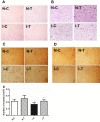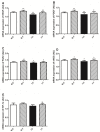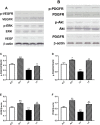Hydrogen sulfide improves vessel formation of the ischemic adductor muscle and wound healing in diabetic db/db mice
- PMID: 31998462
- PMCID: PMC6885384
- DOI: 10.22038/ijbms.2019.36551.8709
Hydrogen sulfide improves vessel formation of the ischemic adductor muscle and wound healing in diabetic db/db mice
Abstract
Objectives: It has been demonstrated that hydrogen sulfide plays a vital role in physiological and pathological processes such as regulating inflammation, oxidative stress, and vessel relaxation. The aim of the study was to explore the effect of hydrogen sulfide on angiogenesis in the ischemic adductor muscles of type 2 diabetic db/db mice and ischemic diabetic wound healing.
Materials and methods: The femoral arteries of diabetic db/db mice were isolated and ligated for preparation of ischemic hind limb model. Round incision was made on ischemic and non-ischemic limbs. The wounds were treated with sodium bisulfide (hydrogen sulfide donor). Real-time PCR and Western blotting were used to measure transcription of vascular endothelial growth factor (VEGF), epidermal growth factor (EGF), platelet derived growth factor (PDGF), hypoxia inducible factor-1α (HIF-1α) and endothelial nitric oxide synthase (eNOS) and protein expression of VEGF, VEGF receptor (VEGFR) and PDGF, PDGF receptor (PDGFR), respectively. Angiogenesis and morphological changes in adductor muscles were observed.
Results: Hydrogen sulfide significantly increased transcription of VEGF, EGF, PDGF, HIF-1α, eNOS and protein expression of VEGF, PDGF, and phosphorylated VEGFR and PDGFR. Treatment with hydrogen sulfide significantly improved ischemic wound healing and formation of granulation tissue, and increased the number of small vessels in the ischemic adductor muscles.
Conclusion: Our data suggested that hydrogen sulfide attenuated injury of ischemic adductor muscle, and promoted the ischemic diabetic wound healing via modulating angiogenesis in type 2 diabetic db/db mice.
Keywords: Adductor muscle Angiogenesis; Diabetes; Hydrogen sulfide; Ischemia; db/db mice.
Conflict of interest statement
The authors declare that they have no conflicts of interest.
Figures





Similar articles
-
Recombinant fusion protein by lysozyme and antibacterial peptide enhances ischemic wound healing via angiogenesis and reduction of inflammation in diabetic db/db mice.PeerJ. 2021 Apr 16;9:e11256. doi: 10.7717/peerj.11256. eCollection 2021. PeerJ. 2021. PMID: 33959422 Free PMC article.
-
Platelet-derived growth factor C promotes revascularization in ischemic limbs of diabetic mice.J Vasc Surg. 2014 May;59(5):1402-9.e1-4. doi: 10.1016/j.jvs.2013.04.053. Epub 2013 Jul 13. J Vasc Surg. 2014. PMID: 23856609
-
Angelica dahurica promoted angiogenesis and accelerated wound healing in db/db mice via the HIF-1α/PDGF-β signaling pathway.Free Radic Biol Med. 2020 Nov 20;160:447-457. doi: 10.1016/j.freeradbiomed.2020.08.015. Epub 2020 Aug 24. Free Radic Biol Med. 2020. PMID: 32853721
-
Potential role of hydrogen sulfide in diabetes-impaired angiogenesis and ischemic tissue repair.Redox Biol. 2020 Oct;37:101704. doi: 10.1016/j.redox.2020.101704. Epub 2020 Aug 29. Redox Biol. 2020. PMID: 32942144 Free PMC article. Review.
-
Recent advances in the mechanism of hydrogen sulfide in wound healing in diabetes.Biochem Biophys Res Commun. 2024 Jan 15;692:149343. doi: 10.1016/j.bbrc.2023.149343. Epub 2023 Dec 3. Biochem Biophys Res Commun. 2024. PMID: 38065000 Review.
Cited by
-
A novel, microvascular evaluation method and device for early diagnosis of peripheral artery disease and chronic limb-threatening ischemia in individuals with diabetes.J Vasc Surg Cases Innov Tech. 2023 Mar 23;9(2):101101. doi: 10.1016/j.jvscit.2023.101101. eCollection 2023 Jun. J Vasc Surg Cases Innov Tech. 2023. PMID: 37152916 Free PMC article.
-
Novel ray of hope for diabetic wound healing: Hydrogen sulfide and its releasing agents.J Adv Res. 2024 Apr;58:105-115. doi: 10.1016/j.jare.2023.05.009. Epub 2023 May 27. J Adv Res. 2024. PMID: 37245638 Free PMC article. Review.
-
Hydrogen Sulfide Actions in the Vasculature.Compr Physiol. 2021 Sep 23;11(4):2467-2488. doi: 10.1002/cphy.c200036. Compr Physiol. 2021. PMID: 34558672 Free PMC article.
-
Silencing cyclophilin A improves insulin secretion, reduces cell apoptosis, and alleviates inflammation as well as oxidant stress in high glucose-induced pancreatic β-cells via MAPK/NF-kb signaling pathway.Bioengineered. 2020 Dec;11(1):1047-1057. doi: 10.1080/21655979.2020.1823729. Bioengineered. 2020. PMID: 32970961 Free PMC article.
-
Gasotransmitter-Induced Therapeutic Angiogenesis: A Biomaterial Prospective.ACS Omega. 2022 Dec 9;7(50):45849-45866. doi: 10.1021/acsomega.2c05599. eCollection 2022 Dec 20. ACS Omega. 2022. PMID: 36570231 Free PMC article. Review.
References
-
- Gregg EW, Gu Q, Cheng YJ, Narayan KM, Cowie CC. Mortality trends in men and women with diabetes, 1971 to 2000. Ann Intern Med. 2007;147:149–155. - PubMed
-
- Dash SN, Dash NR, Guru B, Mohapatra PC. Towards reaching the target: clinical application of mesenchymal stem cells for diabetic foot ulcers. Rejuvenation Res. 2014;17:40–53. - PubMed
-
- Srikanth S, Deedwania P. Primary and secondary prevention strategy for cardiovascular disease in diabetes mellitus. Cardiol Clin. 2011;29:47–70. - PubMed
-
- Nathan DM, Genuth S, Lachin J, Cleary P, Crofford O, Davis M, et al. The effect of intensive treatment of diabetes on the development and progression of long-term complications in insulin-dependent diabetes mellitus. N Engl J Med. 1993;329:977–986. - PubMed
-
- Falanga V. Wound healing and its impairment in the diabetic foot. Lancet. 2005;366:1736–1743. - PubMed
LinkOut - more resources
Full Text Sources
Miscellaneous
